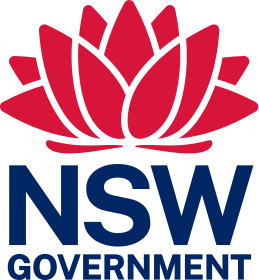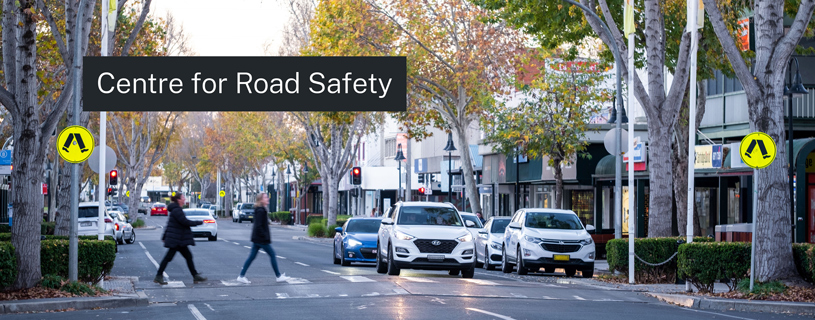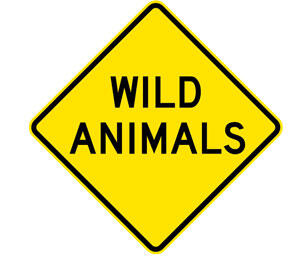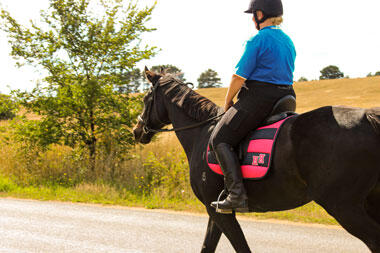Watch for animals
Animals on country roads
Wildlife, wild horses (brumbies) and livestock on the roads can pose an added risk to motorists. 1 in every 41 crashes resulting in injury or death on country roads involve a vehicle hitting an animal.
Image
Image controls:
Wildlife, especially kangaroos and wallabies, may appear on or near the road - particularly around dusk or dawn, when visibility is reduced. They can be fast and unpredictable. When they stray onto the road, it’s hard to know what they’ll do next.
1 in every 41 casualty crashes on country roads involves a vehicle hitting an animal.
Livestock such as cattle and sheep are also sometimes found on or near the road and can present a danger when driving or riding. Slowing down and staying alert, especially around dusk or dawn, could save a collision and save your life.
Safe driving tips
Reduce your speed – Slow down and look out for wildlife on or near the roadside.
Stay alert – Animals can be more active near waterholes and creeks and harder to see at sunrise and sunset. They can be fast and unpredictable. Stay alert and expect the unexpected.
Brake safely – Apply your brakes in a careful, controlled manner. Leave space and pass with care when it is safe to do so.
Don’t swerve – Take great care if you manoeuvre to avoid an animal. You may lose control of your vehicle if you swerve too harshly.
Follow animal warning signs - Take note of warning signs alerting you to the presence of animals in the area. If you see these signs, slow down, stay alert and be prepared to stop if required
- Report injured wildlife – call WIRES on 1300 094 737 or use the IFAW Wildlife rescue app to find a suitable wildlife rescue organisation for your location.
Be prepared
For more information on how to react when you encounter animals on the road, call 13 22 13 or download Animals on country roads (PDF, 713.74 KB).
You can also find more information about sharing the road with horses in the Road User Handbook.
We are dedicated to the conservation of our native animals. For more information, visit Sustainability Transport for NSW.
Horses in traffic
Horse riders have the right to share our roads. They have the same rights and responsibilities as other drivers, motorcycle riders and bicycle riders. Horses can be easily scared so you must take extra care when driving near them.
Safety tips for drivers

- Be aware that horses can be easily frightened and unpredictable.
- Slow down and take extra care on bends, crests and narrow roads, particularly in areas close to horse riding schools or where you see warning signage.
- If you’re passing a horse, whether it’s being ridden or led, or is pulling a vehicle, remember to:
- slow down and allow plenty of room when overtaking
- never use your horn or rev your engine, as this could scare the horse.
- Leave enough room while passing a horse, and don’t drive too fast or make loud noises that can scare a horse.
- If you're involved in a crash, you must stop and provide relevant information. If someone is injured or there's damage to property, call Triple Zero (000). If a horse is injured, contact the nearest vet.
- Report injured wildlife by calling WIRES on 1300 094 737, or use the IFAW Wildlife rescue app to find a suitable wildlife rescue organisation for your location.
- Ensure you're familiar with and follow any warning signs alerting you to the presence of horses.
Safety for horse riders
- Use horse trails where possible. If you do ride on the road, always:
- obey road rules
- avoid tight corners/crests, and instead, ride on roads where drivers have a good line of sight
- ride on the left-hand side of the road in the same direction as the traffic
- use clear hand signals to tell drivers your intent to turn.
- You can walk or ride your horse on footpaths and nature strips unless specifically prohibited and provided you always give way to pedestrians.
- Ride during daylight hours and wear bright coloured clothing.
- You can ride side-by-side with another horse rider as long as there's enough space to do so safely and you’re within 1.5 metres of each other.
- Always wear a helmet that meets Australian Standards.
Other languages
Arabic
عند القيادة على الطرقات الريفية أو الإقليمية، انتبه للحيوانات على الطرقات أو بالقرب منها.
قد تصادف حيوانات مزارع مثل الأبقار، أو حيوانات أسترالية محلية مثل الكنغر أو الومبات. يمكن أن تتحرك هذه الحيوانات بسرعة على الطرقات وقد يصعب التنبؤ بتصرفاتها.
توخَّ الحذر بشكل خاص عند الغسق والفجر، عندما تكون الحيوانات أكثر نشاطاً ويصعب رؤيتها.
قد يكون الاصطدام بحيوان، وخاصة الكنغر الذي قد يكون كبيراً جداً، خطيراً للغاية. فقد سبق أن تعرّض سائقون وركاب لإصابات خطيرة ولقوا حتفهم عندما اصطدمت السيارة التي كانوا يستقلونها بحيوان مثل الكنغر أو البقرة.
لتفادي الاصطدام بحيوان على الطريق، خفّف من سرعتك وابقَ متيقظاً وتوقّع ما هو غير متوقّع.
كن أكثر حذراً إذا رأيت لافتة تحذير من وجود حيوانات على الطريق، فقد يعني ذلك أنك في منطقة مليئة بالحيوانات.
ماذا تفعل إذا رأيت حيواناً على الطريق
إذا رأيت حيواناً على الطريق أو بالقرب منه، خفّف من سرعتك واستخدم المكابح بحذر وبطريقة مُحكمة.
لا تنحرف لتجنّب الاصطدام بحيوان، فقد يتسبّب ذلك في فقدانك السيطرة على سيارتك.
إذا اصطدمت بحيوان، فلا تتوقّف إلا إذا كان ذلك آمناً. وإذا أصيب الحيوان:
- بالنسبة للحيوانات الأسترالية المحلية، اتصل بخدمة المعلومات والإنقاذ والتوعية حول الحياة البرية (WIRES) عبر الموقع الإلكتروني wires.org.au
- بالنسبة للحيوانات الأليفة، اتصل بالمالك أو الشرطة أو RSPCA عبر الموقع الإلكتروني: rspca.org.au.
راكبو الخيول
عند القيادة على الطرق الريفية أو الإقليمية، قد ترى أشخاصاً يركبون الخيول على الطريق أو بالقرب منه.
يمكن أن تصاب الخيول بالذعر بسهولة ولا يمكن التنبؤ بتصرفاتها. يجب على السائقين الانتباه إلى كيفية القيادة حول الخيول وراكبي الخيول.
للبقاء آمناً حول الخيول على الطريق، خفّف من سرعتك وابقَ متيقّظاً وتوقّع ما هو غير متوقع.
كن أكثر حذراً إذا رأيت لافتة طريق تشير إلى وجود راكبي خيول، لأن ذلك قد يعني أنه من المرجّح أن ترى حصاناً على الطريق.
إذا كنت ستتجاوز حصاناً، فيجب عليك:
- أن تخفّف السرعة وتمنح راكب الحصان مساحة كبيرة
- أن تتجنّب استخدام البوق أو زيادة سرعة المحرك أو إصدار أصوات عالية.
澳大利亚野生动物和农场动物
在乡村或偏远地区的道路上开车时,请注意路上和路边的动物。
您可能会遇到牛等农场动物,或袋鼠、袋熊等澳大利亚本土动物。道路上的动物可能行动迅速,而且无法预测。
黄昏和黎明时动物可能更加活跃,而且较难看见,所以您应该特别小心。
与动物相撞可能会很危险,尤其是袋鼠这样体型巨大的动物。曾经发生过汽车与袋鼠或牛等动物相撞而导致司机和乘客重伤和死亡的事故。
为避免在路上撞到动物,请放慢车速,保持警觉,随时准备好应对意外情况。
如果看见动物警告路标,应格外小心,因为这可能意味着您正处于动物活动频繁的区域内。
看见路上有动物时该怎么办
如果看见路上或路边有动物,应减速并以平稳可控的方式刹车。
不要猛打方向盘试图避开动物,因为这可能造成车辆失控。
如果撞到动物,只有在安全的情况下才停车。如果动物受伤:
- 如果是澳大利亚本土动物,请联系野生动物信息、救援和教育服务(WIRES),网址:wires.org.au。
- 如果是家养宠物,请联系主人、警方或RSPCA(网址:rspca.org.au)。
骑马者
在乡村或偏远地区的道路上开车时,您可能会看见路上或路边有人骑马。
马很容易受惊,行为难以预测。司机应该注意避开马匹和骑马者。
在路上遇到马时,为确保安全,请放慢车速,保持警觉,随时准备好应对意外情况。
如果看见骑马者路标,应格外小心,因为这可能意味着您会在路上遇到马。
开车超过马匹时,您应该:
- 放慢车速,给骑马者留出足够的空间。
- 避免按喇叭、轰油门或发出很大的响声。
澳洲動物和農場動物
在鄉村或偏遠道路上行駛時,請留意道路上或附近的動物。
您可能會遇到農場動物,例如牛,或澳洲本土動物,例如袋鼠或袋熊。道路上的動物可能行動迅速且難以預測。
在黃昏和黎明時要尤為小心,那時動物更加活躍,也更難被發現。
與動物相撞,尤其是與體型很大的袋鼠相撞,是非常危險的。在車輛與袋鼠或牛等動物相撞的事故中,曾有駕駛員和乘客遭受重傷甚至死亡。
為了避免在路上與動物相撞,請減速、保持警覺並做好應對突發狀況的準備。
當您看到動物警告的道路標識時,請格外小心,因為這可能表示您正處於動物頻繁出沒的區域。
如果您在路上看到動物該怎麼辦
如果您在道路上或附近看到動物,請減速並以穩健可控的方式踩煞車。
切勿急轉方向盤來避免撞到動物,因為這可能會導致您失去對車輛的控制。
如果您與動物相撞了,在安全的情況下方可停車。如果被撞的動物受傷了:
- 如果是澳洲本土動物,請訪問 wires.org.au 聯繫野生動物資訊、救援和教育服務
- 如果是家養寵物,請聯繫寵物主人、警察或訪問 rspca.org.au 聯繫 RSPCA(皇家防止虐待動物協會)。
騎馬者
在鄉村或偏遠道路上行駛時,您可能會看到有人在道路上或路邊騎馬。
馬很容易受驚並且難以預測。駕駛員應注意如何避開馬匹和騎馬者駕駛車輛。
為了在馬匹附近駕駛時確保安全,請減速、保持警覺並做好應對突發狀況的準備。
如果您看到騎馬的道路標識,請格外小心,因為這可能意味著您更容易在此路段遇到馬匹。
如果您要駕車超越一匹馬,您應該:
- 放慢速度,給騎馬者足夠的空間
- 避免按喇叭、猛踩油門或發出過大的聲音。
Động vật Úc và vật nuôi ở trang trại
Khi lái xe trên các con đường ở nông thôn hoặc tỉnh miền, hãy chú ý đến động vật trên đường hoặc gần đường lộ.
Bạn có thể gặp phải vật nuôi ở trang trại, chẳng hạn như bò, hoặc động vật bản địa của Úc, chẳng hạn như chuột túi hoặc wombat. Động vật trên đường có thể di chuyển nhanh và có thể khó đoán.
Hãy đặc biệt cẩn thận vào lúc hoàng hôn và bình minh, khi động vật có thể hoạt động nhiều hơn và khó nhìn thấy hơn.
Đụng phải động vật, đặc biệt là kangaroo, là động vật rất to lớn, có thể rất nguy hiểm. Tài xế và hành khách đã bị thương nghiêm trọng và tử vong khi chiếc xe họ đang chạy trên đường và đụng vào động vật như kangaroo hoặc bò.
Để tránh đụng phải động vật trên đường, hãy giảm tốc độ, luôn cảnh giác và chuẩn bị cho điều bất ngờ.
Hãy hết sức cẩn thận nếu bạn nhìn thấy biển báo cảnh báo động vật trên đường, vì điều này có nghĩa là bạn đang ở trong vùng có nhiều động vật.
Phải làm gì nếu bạn nhìn thấy một con vật trên đường
Nếu bạn nhìn thấy một con vật trên đường hoặc gần đường lộ, hãy giảm tốc độ và thắng lại một cách cẩn thận, có kiểm soát.
Không lách qua để tránh đụng vào con vật, vì điều này có thể khiến bạn mất kiểm soát xe.
Nếu bạn đụng phải một con vật, chỉ dừng lại nếu điều này an toàn. Nếu một con vật bị thương:
- Đối với động vật bản địa của Úc, hãy liên hệ với Dịch vụ Thông tin, Cứu hộ và Giáo dục Động vật hoang dã (WIRES) tại wires.org.au
- Đối với vật nuôi trong nhà, hãy liên hệ với chủ sở hữu, cảnh sát hoặc RSPCA tại rspca.org.au.
Người cưỡi ngựa
Khi lái xe trên đường nông thôn hoặc tỉnh miền, bạn có thể thấy người cưỡi ngựa trên đường hoặc gần đường lộ.
Ngựa có thể dễ bị hoảng sợ và khó đoán. Tài xế nên lưu ý cách lái xe quanh ngựa và người cưỡi ngựa.
Để đảm bảo an toàn khi lái gần ngựa trên đường, hãy giảm tốc độ, luôn cảnh giác và chuẩn bị cho những điều bất ngờ.
Hãy hết sức cẩn thận nếu bạn nhìn thấy biển báo đường có người cưỡi ngựa, vì điều này có nghĩa là có nhiều khả năng bạn sẽ thấy ngựa trên đường.
Nếu đang vượt qua một con ngựa, bạn nên:
- giảm tốc độ và nhường chỗ rộng cho người cưỡi ngựa
- tránh bấm còi xe, nẹt ga hoặc tạo tiếng ồn lớn.
For more information
An interactive website designed to challenge what you think you know about road safety.
The Road User Handbook covers the main road rules to drive and stay safe on our roads.
Find road safety advice on how to tow and load a caravan safely.






